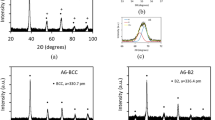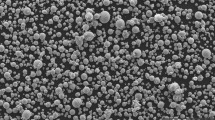Abstract
This work was undertaken to examine the effect of increasing matrix strength at constant equiaxed microstructure on void nucleation and growth in the titanium alloy, CORONA-5, Ti-4.5Al-5Mo-1.5Cr. A martensite and a beta matrix were used in the as-quenched and the heat treated conditions. For each matrix, fine and coarse alpha sizes were produced and a third size of alpha was used for the as-quenched condition of the martensite series. The processing procedures produced an aligned alpha structure which was most pronounced in the fine structure. Void nucleation occurred in an aligned fashion and took place predominantly atα /martensite orα/β interfaces. An explanation is offered for the aligned nucleation in terms of nonuniform deformation of the banded structure which appeared most prominently after heat treatment to produce the coarser microstructure. An incubation strain was found for both types of matrices. The incubation strain increased for the interface in the following order: martensite/martensite,α /martensite, andα/ β. The incubation strain for martensite/martensite interfaces was relatively independent of the matrix strength. Void growth as a function of true strain was generally found to occur in two stages, a slow stage I and a more rapid stage II. Stage II growth occurred as a result of coalescence of voids growing toward one another from nearby particles. Stage II growth was more rapid for the martensite matrix than for theβ matrix. For the martensite matrix void growth rates could not be accounted for either on the basis of strength or strain hardening rates. However, the longest void growth rate was found to increase as the function λN/d Lα increased. λN is the interparticle spacing normal to the tensile axis and Lα is the alpha particle size parallel to the tensile axis. For the beta matrix void growth rates increased with increasing yield s trength and decreased with increasing strain hardening. It was not possible to relate fracture strength to an extrapolated longest void at fracture as was done in earlier studies. This is explained in terms of the nonuniformity of fracture paths observed in the alloy.
Similar content being viewed by others
Abbreviations
- α, β :
-
Hcp (alpha) and bcc (beta) phases
- F, I, C:
-
Fine, intermediate, coarse particle sizes
- f α :
-
Volume fraction of alpha
- d α :
-
Alpha particle size on cross-section plane
- λ:
-
Interparticle spacing on the cross-section plane
- Lα :
-
Alpha particle size parallel to the tensile axis on the longitudinal plane
- λ :
-
Interparticle spacing perpendicular to the tensile axis on the longitudinal plane
- Dβ :
-
Prior beta grain size
- β/α/β :
-
Triple point formed by α/β,β/β, andα/β boundaries
- M:
-
Martensite phase
- v :
-
Longest void length
- G I,IIL :
-
Void growth rates in Stages I and II
- σ fc :
-
Maximum axial stress corrected for necking according to Bridgman
References
R.H. Van Stone, T. B. Cox, J.R. Low, Jr., and J.A. Psioda:International Metals Reviews, 1985, vol. 30, pp. 157–79.
M. A. Greenfield and H. Margolin:Metall. Trans., 1972, vol. 3, pp. 2043–53.
R.H. Van Stone, J.R. Low, Jr., and J.L. Shannon, Jr.:Metall. Trans. A, 1978, vol. 9A, pp. 539–52.
H. Margolin and Y. Mahajan:Metall. Trans. A, 1978, vol. 9A, pp. 787–91.
H. Margolin and L. Rozenberg:Titanium '80 Science and Technology, TMS-AIME, Warrendale, PA, 1981, vol. 3, pp. 1637–43.
H. Margolin and T. V. Vijayaraghavan:Metall. Trans. A, 1983, vol. 14A, pp. 2043–53.
S. Ankem and H. Margolin:Metall. Trans. A, 1982, vol. 13A, pp. 595–601.
S. Ankem and H. Margolin:Metall. Trans. A, 1982, vol. 13A, pp. 603–09.
S. H. Goods and L. M. Brown:Acta Metall., 1979, vol. 27, pp. 1–15.
K. Tanaka, T. Mori, and T. Nakamura:Phil. Mag., 1970, vol. 21, pp. 267–79.
H. Margolin, J. C. Chestnutt, G. Lütjering, and J. C. Williams:Titanium '80 Science and Technology, TMS-AIME, Warrendale, PA, 1981, vol. 1, pp. 169–216.
P. Bridgman:Studies in Large Plastic Flow and Fracture, McGraw- Hill, New York, NY, 1952, pp. 9–37.
Author information
Authors and Affiliations
Rights and permissions
About this article
Cite this article
Vijayaraghavan, T.V., Margolin, H. The effect of matrix strength on void nucleation and growth in an alpha-beta titanium alloy, CORONA-5. Metall Trans A 19, 591–601 (1988). https://doi.org/10.1007/BF02649273
Received:
Issue Date:
DOI: https://doi.org/10.1007/BF02649273




